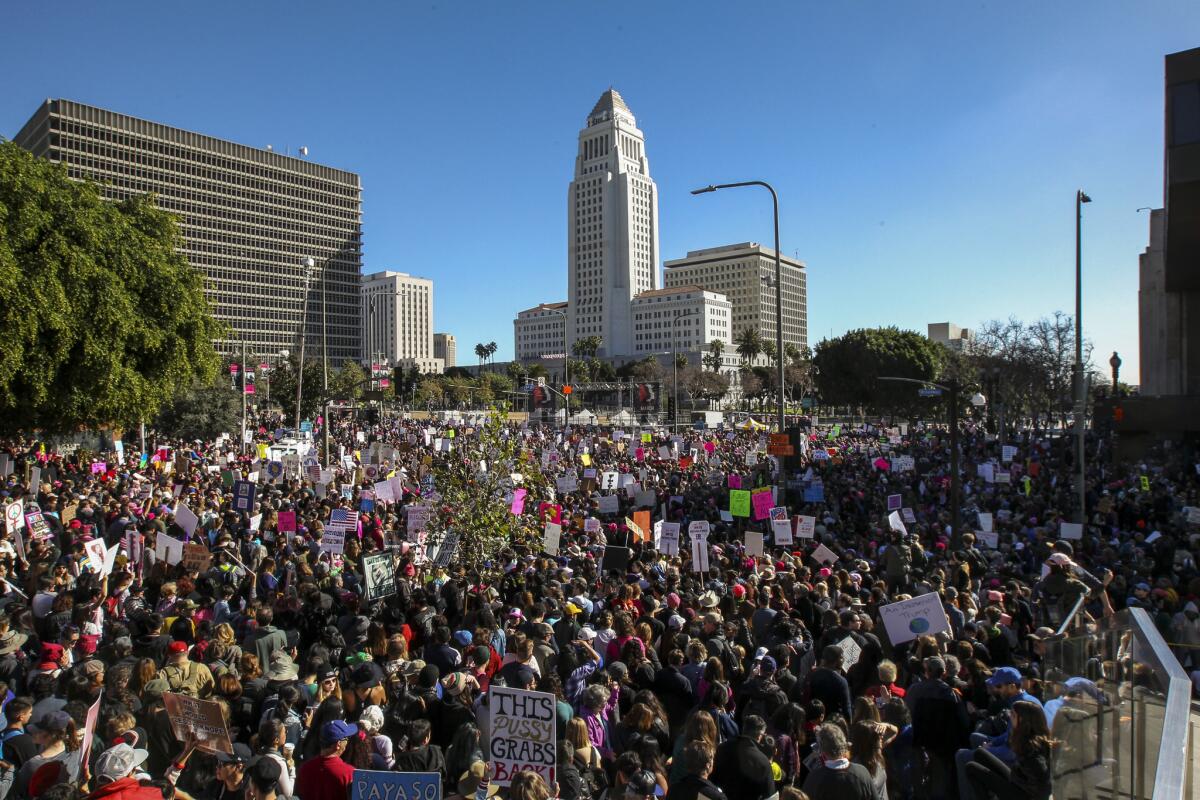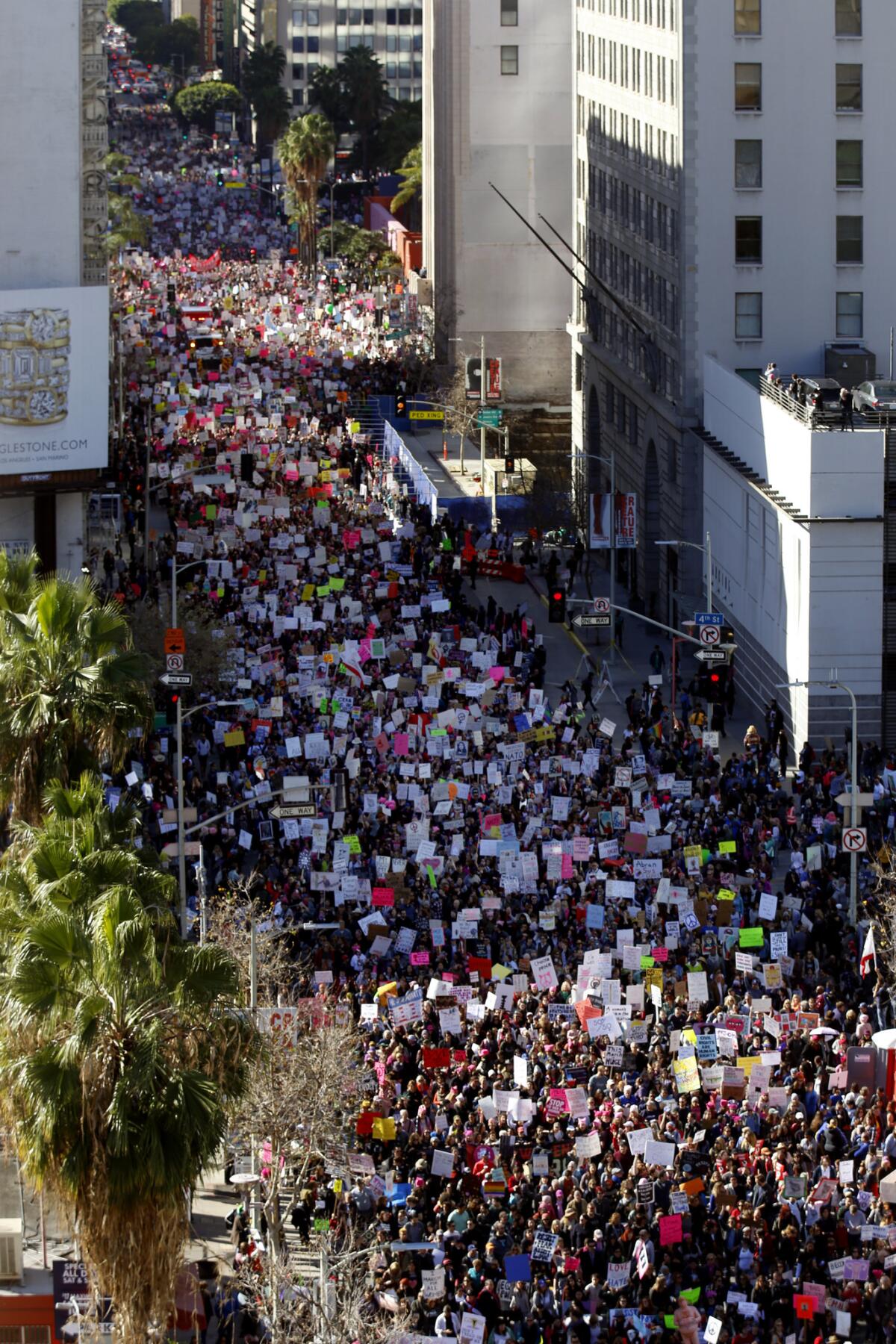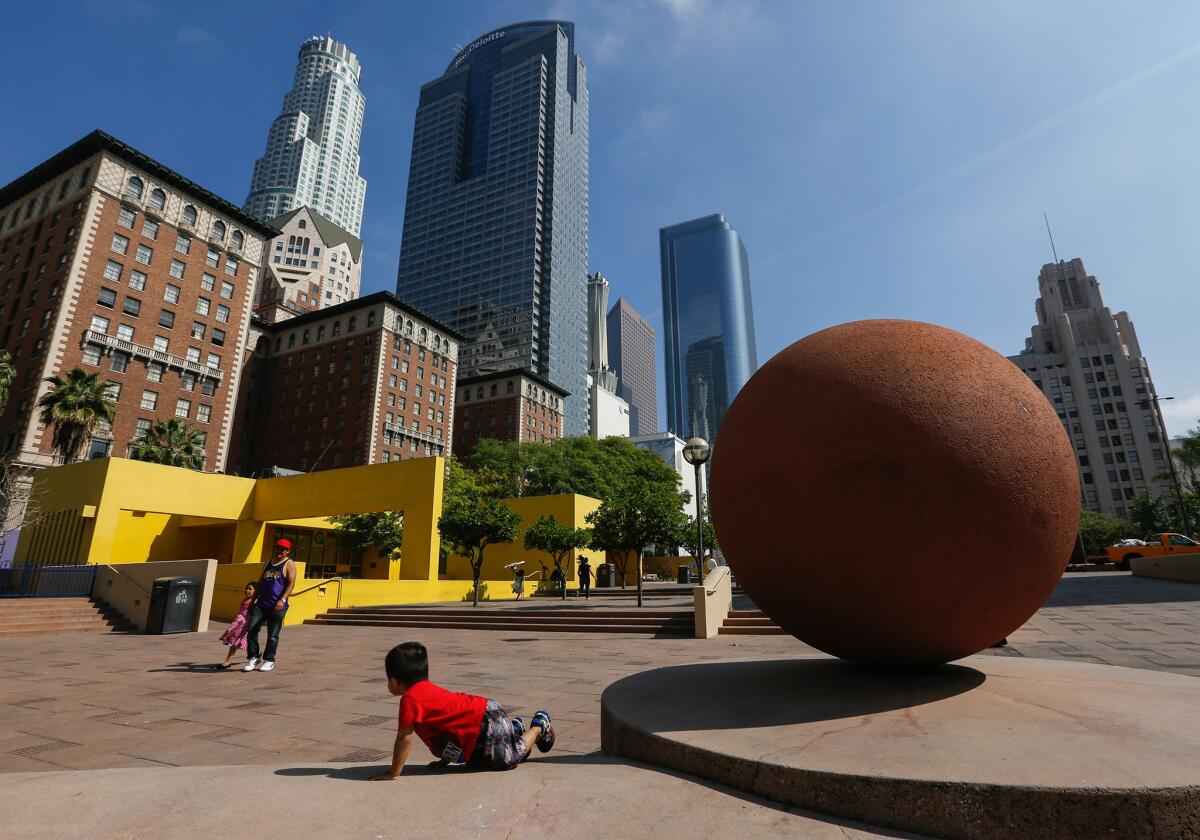In L.A. march, Grand Park performs well with huge crowds; Metro and Pershing Square, not so much

Any big political march is both a test of a city’s spatial limitations and an exercise in seeing and using that city in a new way. This is especially true in Los Angeles, a city still trying to shake off an outdated reputation as a place without a significant pedestrian culture or vibrant public realm.
The Los Angeles edition of Saturday’s women’s march was in that sense another sign of the city’s continuing effort to redefine, or at least recalibrate, its public-ness. The Los Angeles Police Department called it the largest gathering downtown since the giant immigration rights protest of 2006.
What I found most striking as I watched the march descend on Pershing Square and make its way to City Hall was how certain spaces and corridors strained to absorb the unusual mass of humanity while others did so with relative ease. (All morning, the marchers I saw were jovial and relaxed, even when they seemed hopelessly stuck.) In several places, bottlenecks suggested overtaxed infrastructure (and imperfect planning for the march itself). In others the crowd flowed smoothly from one block to the next.
My short-form report card reads this way: low to middling marks for Metro and Pershing Square, high ones for Grand Park.

My experience trying to get on a train Saturday morning at several Gold Line stations matched reports I heard from others or read on social media — that the lines to purchase TAP fare cards or simply to reach Metro platforms were long and snaking, often with no end in sight. Outside two stations I saw families on the sidewalk waiting for surge-priced Uber rides, having given up on the train.
Some of these delays were surely caused by neophyte or inexperienced Metro users, unsure how to load a TAP card. But in my admittedly incomplete survey, I didn’t see any Metro officials directing traffic or giving people at the end of the line a sense of how long they’d be there.
Once downtown, I ended up walking along Grand Avenue, down the hill from Disney Hall and the Broad museum and toward Pershing Square. When I reached the corner of Grand Avenue and Fifth Street, a steep intersection at the base of Bunker Hill, the way to the square was blocked by a mass of people. Traffic cops were still trying to let cars across, even as it became clear that the intersection would soon be overwhelmed by the crowd.
This was a sign, perhaps, that the size of the march had caught city officials by surprise; otherwise this intersection might have been closed to cars far earlier.
FULL COVERAGE: Dispatches from women’s marches around the world »
I eventually made it to the edge of Pershing Square along Olive Street, joining a solid block of people outside the Biltmore Hotel. The crowd seemed anxious to start walking but was hemmed in on all sides, with nowhere to go.
The march might have marked a return to form for Pershing Square, for many decades L.A.’s most important political space. Instead it revealed the limitations of the square’s unpopular 1994 makeover by the late Mexican architect Ricardo Legorreta. Instead of being able to see from Olive into the center of Pershing Square, our view was blocked by the purple and yellow walls Legorreta added along its edges.

It wasn’t difficult, as I stood there, to understand the appeal of a Pershing Square made over in the name of “radical flatness.” That two-word phrase was the guiding slogan for the winning entry, by the French landscape firm Agence Ter, of a 2016 design competition to dramatically reinvent Pershing Square. By “radical flatness” the firm means a square with all those walls removed — a square that is directly open to the streets and sidewalks on all sides, the way it looked for most of the 20th century.
Only in Los Angeles, perhaps, would that basic notion of connectivity seem radical. Still, a square redesigned in that way would have allowed Saturday’s crowd on surrounding streets to see and feel some solidarity with the larger group of protesters.
The part of the march I was in broke from the planned route along Spring Street and stayed on Olive instead, moving slowly past the Omni Hotel and the so-called Erector Set parking structure on Bunker Hill before turning down First Street in the direction of Grand Park and City Hall. It was possibly a measure of the crowd’s size that even this splinter group felt large enough to qualify as the main march, the big mass. Dozens of people had climbed atop the Erector Set; they danced or waved to the marchers below.
Though I didn’t walk directly past the new federal courthouse on First Street, others who did told me it handled the crowd well. Photographs suggested the same. The building, designed by Skidmore, Owings and Merrill to allow the public realm to flow beneath its suspended glass-wrapped cube, apparently worked just as planned.
When I reached Grand Park (not part of the official route, apparently), I found a space — or series of spaces, since the park is broken up by Hill Street and Broadway as they cut across its midsection — that seemed much better equipped to handle a crowd of this size.
The park’s steep grade, as it moves from the top of Bunker Hill to the bottom, can often make it seem an awkward gathering place. But on Saturday the grade was an advantage. Marchers could see all the way down the hill toward City Hall and watch large crowds funneling in from other directions. Their vision wasn’t blocked the way it was around Pershing Square.
There was also more room to maneuver; there were benches and shady corners, places to get away from the throng or rest for a minute or two. At the base of the park along Spring Street, at the foot of City Hall, the crowd was thick. But there were pockets of space for kids to run around and jump in the mud.
But it was really the view down the hill that made the difference. This was even better than radical flatness. This was a way to be in the march and above it at the same time. A crowd doesn’t feel whole unless it can get a glimpse — and a measure — of itself.
christopher.hawthorne@latimes.com
Twitter: @hawthornelat
ALSO
Building Type: Long road to the Arts District’s first park
What does building George Lucas’ museum at Exposition Park say about L.A.?
Architecture’s top 10 for 2016
Building Type: Introducing a weekly column on architecture
More to Read
The biggest entertainment stories
Get our big stories about Hollywood, film, television, music, arts, culture and more right in your inbox as soon as they publish.
You may occasionally receive promotional content from the Los Angeles Times.







